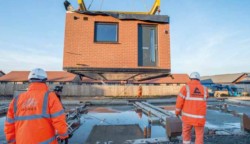When it comes to offsite manufacturing, collaboration is king, says Dave Sheridan, Executive Chairman of ilke Homes, whose firm is at the forefront of delivering quality housing via offsite manufacture.
British construction has “dropped like a stone” according to Duncan Brock, Group Director at the Chartered Institute of Procurement & Supply, as the industry recorded its worst month in a decade, based on the construction Purchasing Managers’ Index (PMI).
Brexit uncertainty, rising construction costs, an aging workforce and the ongoing skills shortage have all been lamented as causes of the current construction crunch. And while some of these factors are having an effect, the overriding reality is that ours is an industry that has sat back and watched the world Google-ise and Apple-ise without ever really trying to keep up. In truth, the fundamentals of housebuilding haven’t shifted in over a century.
Construction is an analogue industry trying to function in a digital world. But this is beginning to change. To propel housebuilding into the 21st century, innovation must steer the sector. We can no longer rely on the traditional methods of building – the industry has to modernise. And it is offsite manufacturing that looks poised to drive the innovation that construction so desperately needs.
You only have to look at the numbers to see why. Offsite manufacturing can create homes twice as fast when compared to traditional construction, can dramatically reduce onsite waste by up to 90% and uses 67% less energy in the manufacturing and construction process, according to the government’s report into modern methods of construction. In addition, these precision engineered homes are more energy efficient, saving consumers up to 30% on their energy bills, the report says.
Offsite manufacturing also requires fewer onsite workers, which is extremely valuable given the current skills shortages that plague the industry. We can quickly and efficiently manufacture these homes from start to finish in our factory, from fullyfitted kitchens to flowing bathrooms, and deliver them to site ready for occupation. Precision-engineered in a factory environment, enhanced by 3D modelling technology and with a superior quality to its traditional counterparts - the housebuilding sector finally has its iPhone moment. But like the iPhone, success can only be measured by sales.
Thankfully for ilke Homes – and for the sector more generally – the momentum is starting to build as the demand for modular homes grows. In May, we signed the single largest modular housing deal in UK history when we agreed to manufacture 750 homes for Places for People, one of the leading placemaking organisations in the country. And we very much see this as just the beginning. We have a current pipeline of 1,200 homes over the next year, with the capacity to manufacture 2,000 in our North Yorkshire factory and plans for additional factories down the line.
But meeting the government’s ambitious target of building 300,000 new homes a year will require more than just us – it will require an entire industry. The ilke Homes and Places for People deal shows that the appetite is there, but at the moment the scale is not. To get to that point, collaboration is required. Modular manufacturers and housing providers must work hand-in-hand to educate, invest and deliver quality homes. And to the credit of the sector and the wider market, these efforts are beginning to pay dividends.
In April, banking goliath Goldman Sachs bet big on the sector by investing £75million into modular manufacturer TopHat. Meanwhile, Homes England and Urban Splash struck a deal with Japan’s biggest modular housebuilder, Sekisui House, for £90million. These deals show without doubt that the mood is changing on offsite manufacturing. Forging these strategic partnerships is the only way that the sector can continue to increase its capacity.
But we also require certainty and stability - things that have always been lacking in construction. Creating certainty and stability was central to our deal with Places for People. Their experience in offsite construction, our strong and long-running relationship between senior leadership, and their burgeoning pipeline meant that this deal was a win-win. It provides our manufacturing facility with a certainty of demand, and their customers with the certainty of high-quality homes.
Through this, we can have the confidence that the delivery of highquality, sustainable and beautiful homes will be met at speed and scale.
And once these fully-fitted homes are craned in, they can be personally transformed into the places that people call home. From first-timebuyers, to families sitting on housing waiting lists, our homes are built for all tenures and at a range of price points. But to do this at the scale required to dent the undersupply of homes, the sector must continue to establish strategic partnerships like ours in order to scale-up the modular housing sector and provide homes to those who deserve them.
In its current state, offsite manufacturing remains relatively small in comparison to traditional housebuilding. Establishing strategic partnerships, like ours with Places for People, must now be a top priority for all offsite manufacturers and housing providers who seek to overcome market fragmentation and bring homes to the market.
Offsite manufacturing is still an emerging industry but its mass-market moment is on the horizon. To get there, we must collaborate across our sector. Offsite manufacturing will undoubtedly be part of the solution to our housing shortfall, but the real question is whether the industry is willing to change. If it’s not, then we can expect more of the same – a worsening skills crisis, continued questions over build quality and lengthening housing waiting lists. Yet, if we finally decide now is the time to modernise and move forward as one, then offsite manufacturing is poised to deliver.









